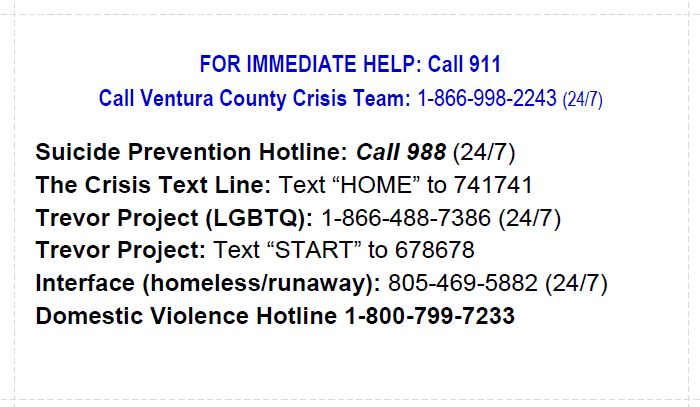
Legislative Requirements
Beginning in the 2020–21 school year, all local educational agencies (county office of education, school districts, state special schools, and charter schools) must adopt, at a regularly scheduled meeting, a policy on pupil suicide prevention that includes kindergarten and grades 1 to 6, inclusive. The policy shall be developed in consultation with school and community stakeholders, the county mental health plan, school-employed mental health professionals, and suicide prevention experts and shall, at a minimum, address procedures relating to suicide prevention, intervention, and postvention. All local educational agencies should already have an existing adopted policy on suicide prevention for grades 7 to 12, required for the 2017-2018 school year (Ed. Code 215).
VCOE’s Suicide Prevention Board Policy states:
Measures and strategies shall include:
- Address the needs of high-risk goups
- Provide provision of information to parents/guardians regarding risk factors and warning signs of suicide,
- Be age-appropriate and sensitive to the needs of young students,
- Include community resources that can help youth in crisis,
- Address any trainings on suicide awareness and prevention to be provided to teachers of all grade levels.
Youth Suicide Prevention Policy Development Resources
Trainings
FREE SUICIDE PREVENTION TRAINING FOR MIDDLE AND HIGH SCHOOL STUDENTS AND STAFF
LivingWorks Start, a 90-minute online training program, teaches life-saving skills to recognize and support those in need. Funded by
Assembly Bill 1808, this interactive training is available at no cost to California middle and high school students (13 years and older) and staff.
You can download a flyer with links to the training here: Livingwork Start
You can also access the training directly at: https://www.lwyouthsummit.com/access-training
FREE TRAINING FOR SCHOOL LEADERS
The Suicide Prevention Ongoing Resilience Training (SPORT) project provides training, support, and resources to implement a sustainable system to deliver suicide prevention, intervention, postvention, and SEL content to school leaders while complying with AB2246 and AB 1767 mandates. Information and registration can be found here: SPORT.
All local educational agencies that serve grades 7-12 and issues student id cards, must print the telephone numbers for suicide prevention and domestic violence hotline numbers on either side of the card. Template for Student ID Cards:

Youth Suicide Warning Signs
Much needed attention has been given to developing suicide awareness and prevention programs for youth, such as safeTALK; however, a solid understanding and agreement on the warning signs for youth suicide has never been accomplished. To address this gap in knowledge, a panel of national and international experts convened to help the public better understand the way youth think, feel, and behave prior to making life-threatening suicide attempts and inform them about how to effectively respond. The main goal was to determine what changes immediately preceded suicide attempts or deaths that are supported by research.
The newly agreed upon list of warning signs and additional resources for how to respond to recognized risk was recently released:
- Talking about or making plans for suicide.
- Expressing hopelessness about the future.
- Displaying severe/overwhelming emotional pain or distress.
- Showing worrisome behavioral cues or marked changes in behavior, particularly in the presence of the warning signs above. Specifically, this includes significant:
- Withdrawal from or changing in social connections/situations
- Changes in sleep (increased or decreased)
- Anger or hostility that seems out of character or out of context
- Recent increased agitation or irritability
More information can be found at Youth Suicide Warning Signs
Additional Resources
- AB 1767 SDCOE Resource Guide for Elementary Schools (PDF)
- After a Suicide: A Toolkit for Schools
- California Department of Education - Youth Suicide Prevention Information - Legislation, publications and additional resources
- Centers for Disease Control and Prevention - Additional resources and statistics on youth suicide
- Comprehensive Suicide Prevention Toolkit for Schools (PDF)
- High School Suicide Prevention Toolkit (SAMHSA, June 2012)
- KeepSafe Connections - List of local and national agencies and their contact information.
- Local and National Resource Guide for Districts and Schools
- National Institute of Mental Health - A wealth of resources regarding various mental health issues in the U.S.
- National Suicide Prevention Lifeline - A 24-hour, toll-free, confidential suicide prevention hotline available to anyone in a suicidal crisis or emotional distress
* Call a suicide hotline number
- 877-727-4747 (24 hours/7 days) Adults - Ventura County Suicide Prevention Center Crisis Line
- 866-431-2478 (24 hours/7 days) Children and Families' Crisis Line
- 800-273-TALK (24 hours/7 days) National Suicide Prevention Lifeline
Trained counselors for free, confidential help
- Substance Abuse and Mental Health Services Administration (SAMHSA)
- Suicide Prevention Awareness
- The Trevor Project: A Model School Policy on Suicide Prevention
The Trevor Project, a leading national organization, offers a policy model for school districts with recommended language that will address prevention, assessment, intervention and response to youth suicide behavior.
- Ventura County 211 - Health and human services referral line
- Ventura County Behavioral Health Crisis Guidelines for Schools
- Ventura County Wellness Everyday
- Youth Suicide Warning Signs
Last updated Aug 2022
Opens in new window
PDF Download
Word Download
Excel Download
PowerPoint Download
Document Download